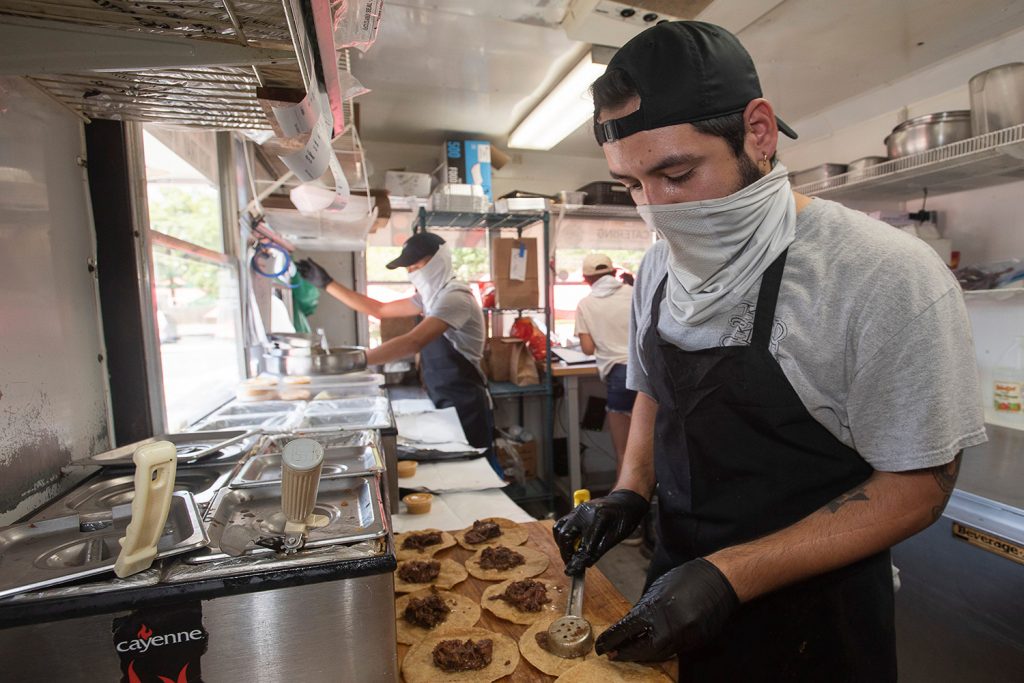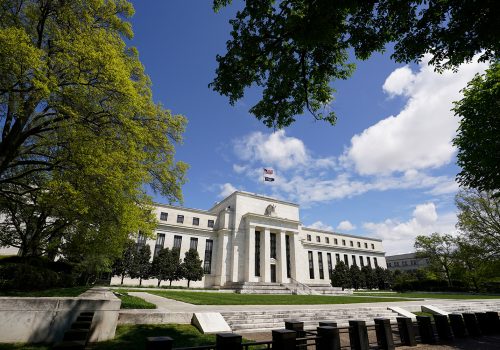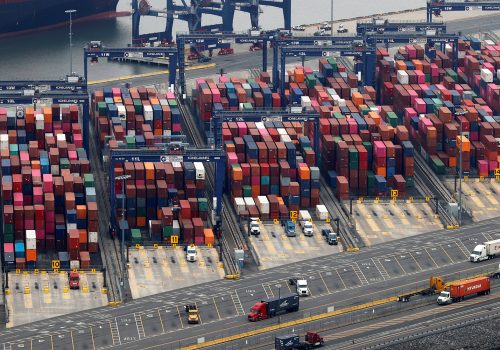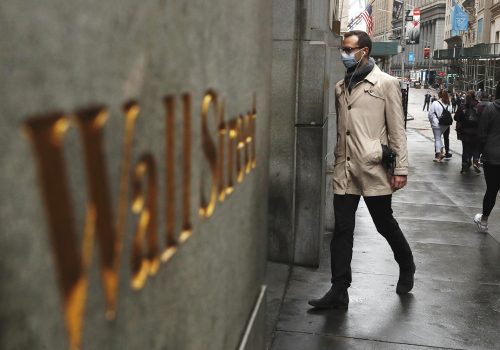As the world has been brought to a standstill—from the dizzying heights of having just surpassed the global record in the volume of air passenger traffic to the ubiquitous grounding of high-flying executives—the coronavirus outbreak has rendered a moment to take a serious look at the way in which we order our societies and our economies.
In the United States, the twinned health and economic crises resulting from coronavirus have laid bare several persistent issues in the socio-economic fabric of the country—and which also complicate the trajectory of sustainable growth for future generations. These issues include fiscal sustainability and ballooning deficits; income inequality and the vast disparity in livelihoods across the income distribution; the hollowing out of the Mittelstand (small and medium enterprises); and the future of work and employment.
Some fret that this moment of humility might be just a temporary lapse, soon to be superseded—perhaps papered over with commercial paper—and forgotten amidst an alacritous return to “business as usual.” And yet, we must not yield to counsels of despair. This will be a “crisis wasted” if we do not acknowledge and instill the principles of solidarity and subsidiarity, the dignity of work, and the recognition that each person matters and has something unique to contribute to society. Moreover, by reimagining its role as “investor of the first resort,” the United States might become a responsible steward for long-term growth, thereby inculcating a greater equality of opportunity across the income distribution.
Fiscal sustainability and ballooning deficits: Whither MMT (Modern Monetary Theory)?
As the coronavirus pandemic has ravaged countries across the globe, central banks and governments have used an unprecedented amount of firepower—via both monetary and fiscal policy—in order to manage the health crisis, shore up economies, and to avert potential financial crises. Governments in advanced economies have committed packages on the order of 10 percent of gross domestic product (GDP) in some cases—with relief packages in the United States far exceeding the stimulus deployed during the Great Financial Crisis (GFC).
The question becomes: With extraordinary measures taken to save lives and to avoid an economic meltdown—combined with a sharp decline in tax revenue for state, local, and federal/national governments—how are we going to pay for all of this debt? Enacting the refrain of former European Central Bank President Mario Draghi to “do whatever it takes” to shore up individuals, households, and economies is certainly justified. But once the health crisis subsides, what are the risks of the mounting debt pile?
In the case of the United States, a procyclical fiscal expansion, declining receipts, and an increase in debt service costs had—prior to the coronavirus crisis—led many to point to fiscal sustainability in the United States as a key risk in the dashboard of the global economy. Nevertheless, the United States’ ability to borrow heavily in debt markets stems from its “exorbitant privilege” of being a fiat currency, the world’s reserve currency, with the US ten-year enshrined as a flight to safety for investors around the globe. Accordingly, the risk of foreign dumping of US treasuries (which some feared during the GFC and recently, during the US-China trade war) is overblown: only one-third of US government debt is owned by foreign governments.
Likewise, the risk of inflation is somewhat overhyped. Demographically speaking, like other advanced economies such as Japan, the United States has been in a deflationary mindset for quite some time. With a declining share of labor income, flat wages for the bottom 90th percentile of the income distribution, the rise of the gig economy, millennials not matching the purchasing power of retiring baby boomers, over-levered households, and inability of a majority of companies to regain pricing power over the consumer since the GFC—combined with historically low demand for key commodities—the risk is in deflation, rather than inflation.
Looking beyond the eventual death of the virus, one of the key issues with keeping the fiscal spigots gushing is that such spending diverts resources away from direly needed investment in social and physical infrastructure. As the coronavirus has so painfully revealed, the United States suffers from an acute shortage of sustainable investments in critical infrastructure such as healthcare, education, broadband and connectivity. Physical infrastructure—such as roads, bridges, hospitals, and even airports—are in exigent need of upgrades. And with gaps in broadband connectivity in some rural areas, many have pointed to the “homework gap” and have called for “broadband equity” in the wake of the coronavirus. Indeed, investing in social and material infrastructure is crucial to heal the great income divide in the United States: as such, excessive spending beyond the coronavirus crisis—and the mounting taxpayer burden of servicing the debt—may come at the cost of growth for future generations and young workers.
Income inequality
Many observers question whether the coronavirus crisis will increase income inequality, which is deeply entrenched in many advanced economies. As one seasoned economist opines, coronavirus is the great “revealer” of the growing gap between rich and poor. The sudden stop to the real economy has decimated employment in jobs for blue-collar workers. Jobs which were naturally growing in increasingly service-oriented economies—such as healthcare, leisure and hospitality, and food service—have been swiftly axed as demand for these services has halted during the coronavirus shutdown. Many of these workers’ households are heavily levered: credit card debt in the United States has reached a historic high of $1 trillion, with many paying between 15-17 percent interest on credit cards.
As a result of the demand shock from the coronavirus, many enterprises are unlikely to recover from the plunge in sales suffered during lockdowns—and probably will face much diminished purchasing power from consumers upon reopening. Consequently, the “savings glut of the rich” is likely to expand significantly. In the United States, striking new research shows that this savings glut has not been matched by corollary investment. In fact, this excess savings is correlated with the expansion of household debt for lower-income households, with the richest households in the United States holding the debt of the middle and poorest income households as an asset class. So with the rich not investing, and, in fact, enabling the increase of more household debt, any eventual economic recovery will almost certainly be unevenly distributed.
The future of work: Solidarity, Mittelstand/subsidiarity, and the dignity of work
Much ink has been spilled on the ways in which the coronavirus has disproportionately impacted blue-collar workers. While white-collar employees and executives are able to telecommute from the safety of their homes, the true “foot soldiers” in this war against the virus are the grocery store checkers and stockers, delivery people, agricultural laborers, building security and maintenance staff, and workers in essential transportation, post offices, and healthcare, to name a few. And, as previously discussed, those recently unemployed constitute the backbone of the real economy in hard-hit sectors such as travel and transportation, leisure and hospitality, non-COVID-19 related healthcare, personal services, and food service. Clearly, this crisis demonstrates the need for solidarity in our societies: in recognizing the true value and dignity of every human being, and the contribution made by many across the income spectrum to keep the economy moving.
It is worth pointing out that interpersonal interactions constitute a common thread of the jobs hardest hit by the pandemic. Many of these jobs are difficult—or almost impossible—to automate. Prior to the outbreak, amidst mounting automation anxiety, many commentators feared that robots were coming for our jobs. However, this economic stop—occurring just after unemployment levels in many advanced economies had hit multi-decade lows—reveals that there were in fact enough jobs to go around – and in some sectors, such as construction, we faced a labor shortage in recent years. Indeed, here is not just one “lump of labor.”
The challenge going forward will be to retrain workers to meet changing patterns of demand. Structural and technological unemployment—by which the skills and tasks of workers have in many cases been substituted with machines—has been a feature of our “new economies” for many decades. Since the 1970s, companies investing in machines have led to an increase in TFP (total factor productivity), resulting in a decline in demand for certain types of skills and labor. There has been a corresponding need for retraining, vocational or tertiary education, learning for working—as such, an alchemy of skills.
Certainly, in the aftershocks of the coronavirus, many of these jobs will be slow to resume, given individual and societal fears of contracting the virus. However, in the medium to long term—and with the eventual development and dissemination of effective vaccines—demand for services are likely to recover, albeit perhaps initially in waves. Hence, we must recognize the grave importance of keeping workers in their jobs for the eventual recovery—something the German system of Kurzarbeit and French policy of chomage partiel do notably well.
In addressing the economic fallout from the coronacrisis, we might also explore structural changes to transform the ways in which small to medium-sized enterprises (SMEs) are supported in the United States. Indeed, part of the hollowing out of the US middle class is linked to the hollowing out of the Mittelstand. The initial confusion in the disbursement of loans in the Paycheck Protection Program perhaps reveals not only the structural challenges facing the United States in lending to small businesses, but also credence to the notion that “bigger is not always better.” The S&P 500 constitutes roughly 17 percent of employment in the United States. Even in terms of typology, the European Union defines a small business as employing zero to forty-nine people, and a medium enterprise as fifty to 249 employees. (Anything 250 or more is classified as a large business). By contrast, in the United States, a small business can have up to 1,500 employees. Clearly, awareness and practice of subsidiarity—that is, understanding that small and local components contribute to the flourishing of socio-economic life—is essential as we emerge from the coronavirus crisis.
Moreover, in the United States, many employers in small businesses hit by the outbreak are faced with the strange reality that some of their employees collect more from unemployment benefits than they do by earning wages. The system is broken if we have removed the capacity for private initiative—and are robbed of the recognition that each person matters and has something unique to contribute to society. This is where the value of the dignity of work comes in. In the wake of the exceptional circumstances of the pandemic, let us do whatever it takes to get workers back on their feet as a transitional program, and by all means, support employers to resume or start business anew once the virus finally abates. As Raghuram Rajan points out, “Nothing erodes a person’s self-worth faster than a sense that they have nothing productive to contribute.”
In exceptional circumstances, and in times of wage compression, governments may need to stand in to provide wage subsidies for workers. Crucially, this is a way to economically empower people, and to amplify their private initiative and so to uphold the dignity of work. As the economic impact of the coronavirus outbreak is likely to disproportionately impact young people, we would do well to use this crisis as a catalyst to provide concrete forms of educational support in “learning for working,” which may mean degree certificates, rather than traditionally conceived modes of higher education. Additionally, while the efficiencies learned by companies during the pandemic may result in more labor displacement, a significant investment in retraining programs is absolutely essential.
Investor of the first resort:
One way out of this crisis is for the United States to reimagine its role and to act as “investor of the first resort”: that is, when governments (for example, Israel and Singapore) take an active stance in seeding investments for future generations and sustainable long-term growth. Such investments—including those in transportation, research and development, science, learning for working, and infrastructure—might yield an internal rate of return, appreciate in enterprise value, and/or harbor an intrinsic social value.
In fact, the composition of government debt in Singapore is divided between “operating” and “development” spending. The government only borrows to fund investments which yield returns and appreciate asset values greater than the amount borrowed; consequently, its net debt to GDP is zero. Notably, in its development spending, Singapore funds a Skills Future program, in which each citizen above the age of twenty-five receives $500 per annum for training on courses to help them to adapt to a changing economic environment.
By contrast, it is a well-known fact that more than 50 percent of the United States’ discretionary spending goes to defense. With an increase in mandatory (or operational) spending to service the national debt—and the crowding out of spending on education, science, and infrastructure—how might it be possible for Washington to cultivate the mindset of a long-term investor, rather than, at times, that of a bailout chief or firefighter? In shifting the mentality from spending to investing, which industries—and therefore investments—are most accretive to long-term growth and to improve the livelihoods of the population? For example, in determining that the cost of transportation was too high, the government of Israel seeded investments in start-ups to focus on solutions for transportation to deploy across the country. Such investments have the capacity to generate jobs, reduce costs, increase productivity, and thereby “flatten the spread” between rich and poor.
Some of these government-seeded investments might also yield fruitful opportunities for the otherwise “savings glut of the rich” via public-private partnerships. Acting as “investor of the first resort” might also take some heat away from our consumption-led model of economic growth—at a moment when consumption is constrained and households are in distress. Additionally, it can help to partially alleviate the debt burden by many state and local governments, for those with the capacity for privatization.
In sum, though coronavirus has wreaked havoc across the globe, it has also paved the way for us to address critical imbalances within our societies—particularly within the United States and other advanced economies. By recognizing the need for solidarity with all parts of the employment spectrum and working to instill greater subsidiarity in supporting small to medium enterprises, we can use this crisis to implement structural changes which are crucial in ensuring a more sustainable and equitable growth. And by acknowledging that each person has something unique to offer to society—and thus honoring the dignity of work—we can take action to provide support for productivity, including learning for working, and investing in critical infrastructure. Finally, a reimagination of the United States’ role—from firefighter to investor of the first resort—will inject a sense of stewardship vitally needed for long-term growth beyond coronavirus.
Dr. Alexis Crow is a nonresident senior fellow with the Atlantic Council’s Global Business and Economics Program and leads the Geopolitical Investing Practice for PricewaterhouseCoopers.
Further reading:
Image: Restaurant workers on 12th Avenue in Pensacola, Florida on Wednesday, May 13, 2020. (REUTERS)



